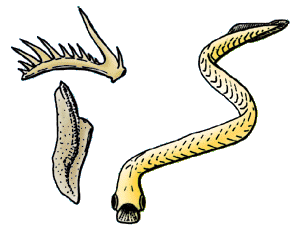Related Research Articles

Conodonts are extinct agnathan chordates resembling eels, classified in the class Conodonta. For many years, they were known only from tooth-like microfossils found in isolation and now called conodont elements. Knowledge about soft tissues remains limited. The animals are also called Conodontophora to avoid ambiguity.
The Darriwilian is the upper stage of the Middle Ordovician. It is preceded by the Dapingian and succeeded by the Upper Ordovician Sandbian stage. The lower boundary of the Darriwilian is defined as the first appearance of the graptolite species Undulograptus austrodentatus around 467.3 million years ago. It lasted for about 8.9 million years until the beginning of the Sandbian around 458.4 million years ago.
Prioniodontida, also known as the "complex conodonts", is a large clade of conodonts that includes two major evolutionary grades; the Prioniodinina and the Ozarkodinina. It includes many of the more famous conodonts, such as the giant ordovician Promissum (Prioniodinina) from the Soom Shale and the Carboniferous specimens from the Granton Shrimp bed (Ozarkodinina). They are euconodonts, in that their elements are composed of two layers; the crown and the basal body, and are assumed to be a clade.
Periodon is a genus of conodonts which existed in what is now Canada, Iran, Argentina, China, Russia, and the United States during the Ordovician Period. It was described by Hadding in 1913, and the type species is P. aculeatus.
Westergaardodina is a species-rich genus of spine, U or W-shaped paraconodont known from Middle Cambrian to Lower Ordovician strata.
Iapetognathus is a genus of cordylodan conodonts. It is one of the oldest denticulate euconodont genera known.
Ozarkodinida is an extinct conodont order. It is part of the clade Prioniodontida, also known as the "complex conodonts".
Erraticodon is an extinct genus of conodonts in the family Chirognathidae.
Paracordylodus is an extinct genus of conodonts in the clade Prioniodontida, also known as the "complex conodonts". The species P. gracilis has been recovered from the chert of the Narooma Terrane, a geological structural region on the south coast of New South Wales, Australia.
Appalachignathus is a genus of multielement conodonts from the Middle Ordovician of North America.
Iapetonudus is an extinct genus of conodonts.

Acanthodus is an extinct genus of conodonts.
Kallidontus is an extinct genus of conodonts.

Variabiloconus is an extinct genus of conodonts.
Eoconodontus is an extinct genus of conodonts of the Late Cambrian. It is a two-elements genus from the Proconodontus lineage.
Baltoniodus is an extinct genus of conodonts.
Histiodella is an extinct genus of conodonts.
Idiognathoides is an extinct genus of conodonts.
Cryptotaxis is an extinct genus of conodonts in the family Cryptotaxidae from the Famennian.
Scotlandia is an extinct genus of conodonts in the family Prioniodinidae.
References
- ↑ Vom Anfang, Hochstand und Ende eines Epikontinentalmeeres. Maurits Lindström, Geologische Rundschau, March 1971, Volume 60, Issue 2, pages 419-438, doi:10.1007/BF02000464
- ↑ Morphology, evolution and stratigraphic distribution in the Middle Ordovician conodont genus Microzarkodina. Anita Löfgren and Tatiana Tolmacheva, Earth and Environmental Science Transactions of the Royal Society of Edinburgh, Volume 99, Issue 01, March 2008, pages 27-48, doi : 10.1017/S1755691008007056